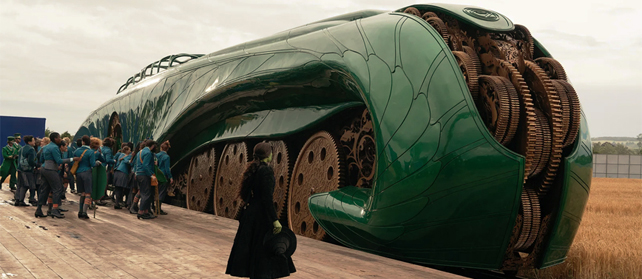Nathan Crowley 2.0

AS: For something like the train in Wicked, would that have started with you doing a preliminary sketch and then handing it over to an illustrator or set designer?
NC: Yes, I determined the shape and then I worked with illustrators on it. I then worked with an art director in Rhino and then we went to 3D printing. Then I went to a graphics person in the art department to figure out the beautiful patterning of the wood panels. The way we built the train is we cut the frame out of steel and applied a series of panels. The panel makers can only make them a certain size so all the patterning had to work within that fixed panel size before being hard-coated and painted.
Ultimately, everyone else gets involved in the train’s construction. Props starts making me the cogs and the wheels. I always knew I wanted big wheels, eight or nine foot ideally, because I wanted Galinda and Elphaba to stand in front of these great, golden wheels. They ended up coming down to about seven feet because the train was getting too tall and we wouldn’t have been able to transport it anywhere! Apparently sixteen foot is a good size for the height of a train. And I also always knew I wanted the wheels angled in, so it felt like the train had forward momentum.
The idea was that there are no doors on the train, like an old American Western train, and you just jump on. They had to jump in the middle because in the very back I needed to include a cockpit area that gave you nostalgia for the back of a Louis the XIV carriage. It feels a little bit romantic and feminine. I think building these sets is the most fun I’ve ever had on a film.
AS: Another memorable set piece in Wicked was the big Oz head that articulates. Did that also start out with art directors and 3D printing?
NC: That was the same art director that looked after the train. He comes from a miniature background. He’s good with maquettes. I knew we had to build a maquette and needed to puppeteer it. And the Special Effects department had a brilliant puppeteer they’d used before called Chris [Dalton]. He motorized this little scale maquette to show Jon Chu how many expressions you could get out of it. Then it was about getting SFX to scale that all up. The hydraulics were hung off the ceiling on that stage!
AS: What was it like working with director Jon Chu compared to Christopher Nolan or Damien Chazelle?
NC: Every director is just completely different! I got lucky, I found Chris and Damien who I adored working with, who are oddly similar in their approach, and then now I’ve met Jon Chu who’s so very different and he’s just this sort of magnificent, generous person who is obsessed with dance and music and storytelling.
AS: Was he very focused on the visuals? I remember you talking about how Christopher Nolan used to go kit-bashing with you at Home Depot. How hands-on was Jon?
NC: It was different because Jon had all these dance numbers to create and figure out so he was gone a lot to the dance studio or the recording studio. There’s this whole other element of filmmaking in musicals that he had to concentrate on. He was usually around in the mornings because the dancers liked to dance in the afternoons.
In terms of being hands-on, it’s important to express to a director coming into the art department that nothing is precious. Nothing is sacrosanct until it’s captured on film. A beautifully crafted model is merely a starting point. I use white card models to express that. I encourage a hands-on approach. People try and stop me from ripping apart the model but it’s all done to make them feel like it’s theirs as well. After all, it’s just card! Get a scalpel, get a paint brush and have a go! You want everyone to be part of it. Early on, Jon would join in, saying, I’m going to pull this apart as well, I don’t like this bit. I’d say, Great! That hands-on collaboration is an integral part of my creative process.